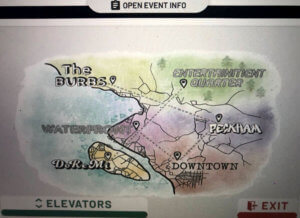
The event-technology platform Gatherly uses “spatial video chat” to foster one-on-one and small-group connections in digital meetings.
At the beginning of 2020, a team of computer science students from Georgia Tech, Columbia University, and the Wharton School at the University of Pennsylvania were in the midst of launching a startup as part of Georgia Tech’s Create-X Startup Launch program. Their company was based on their design of a 3D scanner that measures muscle mass and body fat and is intended for use at gyms and fitness centers — and then the pandemic closed down gyms, ending much of the fledgling company’s sales prospects.
The students went “back to the books,” said company co-founder and CEO Christopher Cherian, a student at Wharton, pursuing a strategy they learned from their professor mentors — paying attention to problems they could solve. As the pandemic stretched on and students spent more of their time going to class and socializing online, “a huge problem” became increasing apparent, Cherian said — the difficulty of making meaningful personal connections online while in a group.
“I would be on these 300-, 400-, 500-person video calls where it was just really hard to have a personal conversation,” he said. “One of the things that I remember very distinctly from the end of last semester was, when we were doing the senior sendoff for the graduating class, I was trying to say goodbye to this one senior in particular, and it was just so awkward — there were 200 eyeballs watching me say goodbye. In person, you wouldn’t have 200 people watching you go up to a person, give them a hug, and shake their hand to say congratulations.”
That became the seed for an event-technology platform called Gatherly, founded in March. The solution the students designed is a two-dimensional model that allows participants to move around on screen “maps” as avatars, represented by colored dots — when two or more dots are close together, those participants can video chat with each other. Users do a variety of things in the platform, including attend livestreamed sessions, but that functionality — which Gatherly’s founders call “spatial video chat” — sets it apart.

Gatherly’s interface can be customized graphically to fit with customer brands — there is “no one-size-fits-all event,” said CEO Christopher Cherian.
On the surface, the platform, which looks a little like a first-generation computer game, seems almost disconcertingly simple. But it is designed to accommodate multiple layers and hundreds of users, organized in levels that participants find by using “elevators” at the edges of the platform map. Users can add as many groups and levels as they like, along with graphic “skins” to match their brand and aesthetic. Gatherly can be used to host an entire conference or trade show, or just for networking.
Founded in March, Gatherly now hosts an average of 40 events a week, according to Cherian. Customers have ranged from universities to corporations including General Electric and Capgemini, Cherian said. Their customer base can be segmented into three major areas: academic events, “where, of course, everything is shuttered,” Cherian said, and nonprofits and corporations. Gatherly is focusing on galas and fundraisers, sponsorship conferences, happy hours, and networking events, Cherian said. “We think people use this for tons of different use cases and there’s really no one-size-fits-all event. It’s really up to you.”
I tested an early iteration of Gatherly last summer, when event consultant Adrian Segar invited event professionals to an online event, using Gatherly as a networking platform. I loved the ability to move around online, but when I was in a “room” with a dozen or so other participants, I also felt awkward, not knowing if other participants were open to talking to me. I missed the nonverbal cues — like averted eyes — that we can pick up in live settings. I left quickly — the online equivalent of escaping to my hotel room.
That’s something that Gatherly is trying to address. “Because the interactions are simplified on our platform, it is kind of lacking in some sort of body language,” said Lulu Gao, Gatherly’s UX designer. Gatherly already has added a “lock” feature to conversations, so that participants can indicate to others that they would like their chat to remain private. “It is something that the team is working on,” Gao added, “making joining and leaving conversations as seamless as possible.”
Barbara Palmer is deputy editor of Convene.
